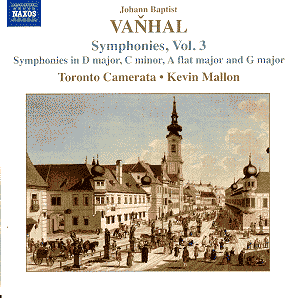A contemporary of Mozart and Haydn, Johann Baptist Vaňhal
was born in the Bohemian village of Nechanicz where he received
a wealth of musical instruction. Upon moving to Vienna in 1760,
he became one of the most popular composers in Europe, writing
about 20 symphonies, 6 flute quartets, and two substantial sacred
choral works. However, as with most of the composers of the
Classical era, Vaňhal became quite obscure after his death.
Naxos is certainly doing its part to lift Vaňhal's
music into the mainstream. In addition to the Symphonies cycle
(of which this is volume 3), the company has released a disc
of his sacred choral music. These recordings reveal an expert
and highly imaginative composer whose symphonies compare well
to the early efforts of Mozart and Haydn. Vaňhal's melodies
are very attractive and sometimes memorable, Viennese charm
is prevalent in the slow movements, and the outer movements
are exuberant and robust.
Each of the four programmed symphonies is in four movements
sequenced as follows: Allegro - Andante or Adagio - Menuetto
- Allegro. The Symphony in D major is one of Vaňhal's earliest
orchestral works. The opening Allegro is rather short at just
over two minutes, but makes amends through its hard-driving
rhythms that are quite exciting. The Andante oozes with lilting
elegance, the Menuetto is a delightful and regal affair, and
the concluding Allegro is in perpetual-motion and permeated
with a moderate degree of angst. The other symphonies on the
disc largely adhere to the description of the Symphony in D
major except that the movements are longer, thematic development
more pronounced, and first movements exhibit an enticing mix
of charm and excitement rather than only the latter.
I consider the Symphony in G major particularly rewarding.
The 1st Movement finds the composer at his highest level of
inspiration. The initial theme is elegant to the core and offered
by Vaňhal in six complete statements; further, each statement
highlights his most powerful and tension-laden utterances. The
2nd Movement Andante, similar to the Symphony in D major, possesses
a lilting poetry that is thoroughly compelling and upbeat with
an attractive solo flute part that doubles the first violin
melody. In the 3d Movement, we have a Menuetto I and II; the
first is joyous and well contrasts with the second that introduces
some doubt and anxiety. From the vivacious opening theme to
the drama/desperation conveyed in the development section as
it moves through three different minor keys, the 4th Movement
is riveting throughout. This is an exceptional symphony for
its time period and not to be missed.
Adding to the enjoyment of the disc is the crisp and
idiomatic playing of the Toronto Camerata with principal artists
from the Toronto Symphony, the Canadian Opera Orchestra, the
Canadian Ballet Orchestra, and the period instrument band Tafelmusik.
This chamber orchestra is under contract to Naxos for the next
few years and has already recorded the music of Saint-Georges
and C.P.E. Bach in addition to the Vaňhal disc. Although
using modern instruments, the group's playing is historically
informed, lean and fully displays Vaňhal's penchant for
lilting Viennese charm and exciting Allegro movements. I can't
imagine better performances of Vaňhal's music and look
forward to their future recordings. The soundstage is also excellent,
highlighting the sharply etched and assertive interpretations.
In conclusion, this new Vaňhal disc is strongly
recommended for all those with a warm spot for the orchestral
music of the Classical era. Vaňhal's music is immediately
appealing and retains it luster after repeated listenings. Once
again, Naxos proves that there are treasures well beyond the
beaten path. There is another fine disc of Vaňhal symphonies
on the Chandos label, but the Naxos super-budget price tag can't
be beat.
Don
Satz

![]() Toronto Camerata/Kevin Mallon
Toronto Camerata/Kevin Mallon![]() NAXOS
8.557483 [69:19]
NAXOS
8.557483 [69:19]





